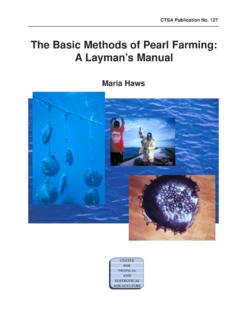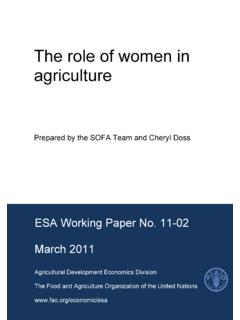Transcription of Farmers’ Attitudes Towards On-Farm Cultivation of ...
1 Ethnobotanical Leaflets 14: 366-380. 2010. Farmers' Attitudes Towards On-Farm Cultivation of indigenous fruit Trees in Adwari Sub-County, Lira District, Uganda Jacob Godfrey Agea1, Joseph Obua2, Daniel Waiswa3, Clement Akais Okia1. and J. B. L. Okullo2. 1. Department of Community Forestry and Extension 2. Department of Forest Biology and Ecosystems Management 3. Department of Forest Management Makerere University, Box 7062 Kampala, Uganda E-mail: Issued March 1, 2010. Abstract This study was conducted in Adwari sub-county, Lira district to (i) determine the conservation status and threats to indigenous fruit trees (IFTs), (ii) assess farmers'. Attitudes Towards IFT Cultivation , (iii) documents local knowledge on propagation and management of IFTs, and (iv) identify opportunities and constraints to promotion of IFTs Cultivation .
2 Semi-structured questionnaires were administered to a total of 120 randomly selected respondents. MINITAB statistical package was used to analyze the data. Logistic regression analysis was performed to show the influence of socio-economic characteristics on farmers' Towards their Attitudes to plant IFTs. The population of IFTs was found to be generally declining. The major reasons for decline were charcoal burning and firewood collection. Although, majority of farmers had positive Attitudes Towards Cultivation of IFTs, their Attitudes were influenced by gender, education level, farm size and occupation status. Lack of clear markets for indigenous fruits, unclear information about their food values, lack of seedlings in local nurseries, and dearth of information propagation techniques were the major hindrance to Cultivation of IFTs.
3 There is a need especially by local governments and local councils to formulate clear strategies on conservation of IFTs for example by establishing a community nursery and propagation center for IFTs. There is a need to address the issue of marketing and pricing of indigenous tree fruit products. Lastly, there is a need of further study to analyze the market environment for indigenous tree fruits compared with alternative possibilities such as exotic fruits or agricultural crops. Key words: Domestication, wild fruits, farming systems, food security, Uganda. 366. Introduction indigenous fruit trees (IFTs) can contribute to cash economy of small-scale farmers (Okafor, 1988). Some of the fruits can be processed to make juice, wine, jam, chutneys and animal-feed concentrates.
4 With increased climatic instability causing frequent agricultural crop failure, the role of indigenous fruit in providing nutritional supplement to mankind is gaining recognition (Maghembe, 1995). During drought periods indigenous food plants provide food and income to rural households (Eriksen and Mutimba 1998). Fruits such as Adasonia digitata provide dietary supplement and are often sold in local markets (Arum, 1989). According to Campbell (1987), IFTs are not normally included in agricultural policies and have been neglected by research and extension programmes by many developing countries. They have faced a great danger in the recent past due to high population growth, which exerted high pressure on woodland resources (Ondachi, 1999).
5 For a long time, mankind has relied on these resources without managing them or putting in any effort to propagate them. This, coupled with lack of ex situ conservation strategies, has led to their loss in the natural woodlands and forests (Ondachi, 1999). It is no longer possible to leave such strategies to nature to provide the genetic resources. Planting of IFTs On-Farm therefore not only has the potential of improving food security but also conservation of biodiversity On-Farm (Brownrigg, 1985). In Uganda, however, little research has been undertaken on IFTs. Moreover, there is a dearth of information on IFTs that can be incorporated in the farming practices. Under the proposed programmes for improved delivery of agricultural and forest services, each district will be expected to work within the framework of the National Forest Plan (NFP), Plan for Modernization of Agriculture (PMA) and National Agricultural Advisory Services (NAADS).
6 In the NFP, districts will be expected to develop and advise on agroforestry technologies (FSCS, 2002). The promotion of On-Farm tree planting and indigenous fruit tree domestication will be prominent features in the delivery of service to farmers. However, this will be hampered by lack of information on the fruit trees that can be selected for domestication. The specific objectives were to (1) determine the conservation status 367. and threats to IFTs, (2) assess farmers' Attitudes Towards IFTs Cultivation , (3). document indigenous knowledge on propagation and management of IFTs, and (4). identify the opportunities and constraints to promotion of IFTs Cultivation in Adwari, Lira district.
7 Materials and Methods The study was conducted in Adwari sub-county found in Otuke county, Lira district in the northern part of Uganda. Adwari is located between 2 25 - 2 47 N. and 33 02 - 38 38 E (LDSOER, 1997). The largest part of the sub-county has acidic and deeply weathered soils with low cation exchange capacity (LDSOER, 1997). The average minimum and maximum temperatures are C and C. respectively. The average annual rainfall is 1200 mm. The sub-county is covered with wooded savanna. Large areas of original tree -savanna occupied areas have been taken over by farming and grazing. About 82% of the total population and 79% of the households derive their livelihood from farming. Semi-structured questionnaires were administered to a total of 120 randomly selected respondents.
8 The purpose was to capture data on the socio-economic profile of the farmers, their Attitudes and willingness Towards indigenous fruit tree Cultivation , indigenous knowledge on propagation and management of IFTs, opportunities and constraints to promoting Cultivation of IFTs. The area was stratified into seven administration units (parishes) and respondents from each unit were selected systematically for the interview. The number of respondents selected from each unit ranged from 15 to 17, relative to the size of its population. MINITAB. statistical package was used to analyze the data. Logistic regression analysis (Green, 1995) was performed to show the influence of socio-economic characteristics on local farmers' Attitudes and willingness to plant IFTs.
9 Results and Discussion Demographic and socio-economic characteristics of respondents The majority (66%, Table 1) were aged between 20-40 years. Seventy four percent of the respondents were male and 75% were subsistence farmers. Eighty five percent were married; the majority had attained either primary or secondary 368. education and the average family size was seven people per household. About 68%. of the respondents had an average annual income ranging from Shs. 101,000 - 200,000. About 72% had more than 6 ha of land and 60% of the land, had less than 25% tree cover. Conservation status and threats to IFTs The population of the 10 most preferred indigenous fruit tree species is declining in Adwari sub-county (Figure 1).
10 This decline is a challenge to the National Forest Plan (NFP) and Plan of Modernization of Agriculture (PMA) when considering Cultivation of IFTs as the wild populations would be the major source of planting materials. The main threats to IFTs are tree cutting for charcoal and firewood, reported by 68% and 55% of the respondents respectively. Wild fires in the dry season and clearing agricultural land are other important threats (Figure 3). Exploitation of wood for making mortars, timber and house construction, beehives and inability of some trees to sprout are the other threats to conservation of IFTs. Farmers' thoughts about IFTs Cultivation Generally, there were positive feelings Towards IFTs Cultivation .




![[2009] ZACC 11 BERTIE VAN ZYL (PTY) LTD First Applicant ...](/cache/preview/e/c/0/d/e/9/e/e/thumb-ec0de9ee724aceff5b85d1fb2d2dd7a1.jpg)


![The Sahel Tropical Hot Desert Case Study [LEDC]](/cache/preview/3/7/9/d/9/9/3/1/thumb-379d99319dc04e58e763fa042804490d.jpg)

